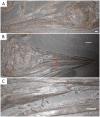Ontogenetic Tooth Reduction in Stenopterygius quadriscissus (Reptilia: Ichthyosauria): Negative Allometry, Changes in Growth Rate, and Early Senescence of the Dental Lamina
- PMID: 26579712
- PMCID: PMC4651570
- DOI: 10.1371/journal.pone.0141904
Ontogenetic Tooth Reduction in Stenopterygius quadriscissus (Reptilia: Ichthyosauria): Negative Allometry, Changes in Growth Rate, and Early Senescence of the Dental Lamina
Abstract
We explore the functional, developmental, and evolutionary processes which are argued to produce tooth reduction in the extinct marine reptile Stenopterygius quadriscissus (Reptilia: Ichthyosauria). We analyze the relationship between mandible growth and tooth size, shape, and count, to establish an ontogenetic trend. The pattern in S. quadriscissus is consistent with hypotheses of tooth size reduction by neutral selection, and this unusual morphology (a functionally edentulous rostrum) was produced by a series of different evolutionary developmental changes that are known for other taxa showing tooth reduction and loss. Specifically, this species evolved functional edentulism by evolutionary changes in the growth allometry of the dentition and by altering growth rates through ontogeny. This observation supports previous hypotheses that S. quadriscissus underwent ontogenetic tooth reduction. Tooth reduction in S. quadriscissus may be caused by unique selective pressures resulting from prey choice and feeding behavior, expanding our current understanding of the mechanisms producing tooth reduction.
Conflict of interest statement
Figures








Similar articles
-
Ontogenetic variation in the skull of Stenopterygius quadriscissus with an emphasis on prenatal development.Sci Rep. 2022 Feb 1;12(1):1707. doi: 10.1038/s41598-022-05540-0. Sci Rep. 2022. PMID: 35105895 Free PMC article.
-
Illustrating ontogenetic change in the dentition of the Nile monitor lizard, Varanus niloticus: a case study in the application of geometric morphometric methods for the quantification of shape-size heterodonty.J Anat. 2015 May;226(5):403-19. doi: 10.1111/joa.12293. Epub 2015 May 4. J Anat. 2015. PMID: 25939576 Free PMC article.
-
Dental ontogeny in extinct synapsids reveals a complex evolutionary history of the mammalian tooth attachment system.Proc Biol Sci. 2018 Nov 7;285(1890):20181792. doi: 10.1098/rspb.2018.1792. Proc Biol Sci. 2018. PMID: 30404877 Free PMC article.
-
Biological spacetime and the temporal integration of functional modules: a case study of dento-gnathic developmental timing.Dev Dyn. 2008 Jan;237(1):1-17. doi: 10.1002/dvdy.21383. Dev Dyn. 2008. PMID: 18058914 Review.
-
The genetic basis of modularity in the development and evolution of the vertebrate dentition.Philos Trans R Soc Lond B Biol Sci. 2001 Oct 29;356(1414):1633-53. doi: 10.1098/rstb.2001.0917. Philos Trans R Soc Lond B Biol Sci. 2001. PMID: 11604128 Free PMC article. Review.
Cited by
-
Dietary niche partitioning in Early Jurassic ichthyosaurs from Strawberry Bank.J Anat. 2022 Dec;241(6):1409-1423. doi: 10.1111/joa.13744. Epub 2022 Sep 29. J Anat. 2022. PMID: 36175086 Free PMC article.
-
Ontogenetic variation in the skull of Stenopterygius quadriscissus with an emphasis on prenatal development.Sci Rep. 2022 Feb 1;12(1):1707. doi: 10.1038/s41598-022-05540-0. Sci Rep. 2022. PMID: 35105895 Free PMC article.
-
Cranial anatomy of Besanosaurus leptorhynchus Dal Sasso & Pinna, 1996 (Reptilia: Ichthyosauria) from the Middle Triassic Besano Formation of Monte San Giorgio, Italy/Switzerland: taxonomic and palaeobiological implications.PeerJ. 2021 May 6;9:e11179. doi: 10.7717/peerj.11179. eCollection 2021. PeerJ. 2021. PMID: 33996277 Free PMC article.
-
The first articulated skeletons of enigmatic Late Cretaceous billfish-like actinopterygians.R Soc Open Sci. 2023 Dec 6;10(12):231296. doi: 10.1098/rsos.231296. eCollection 2023 Dec. R Soc Open Sci. 2023. PMID: 38077217 Free PMC article.
References
-
- McGowan C. A revision of the Lower Jurassic ichthyosaurs of Germany with descriptions of two new species. Palaeontographica Abteilung A. 1979; 166(4–6):93–135.
-
- Heyning J, Mead J. Suction feeding in beaked whales: morphological and observational evidence. Smithsonian Contributions to the Marine Sciences. 1996. December 12; 464:1–12.
Publication types
MeSH terms
LinkOut - more resources
Full Text Sources
Other Literature Sources

